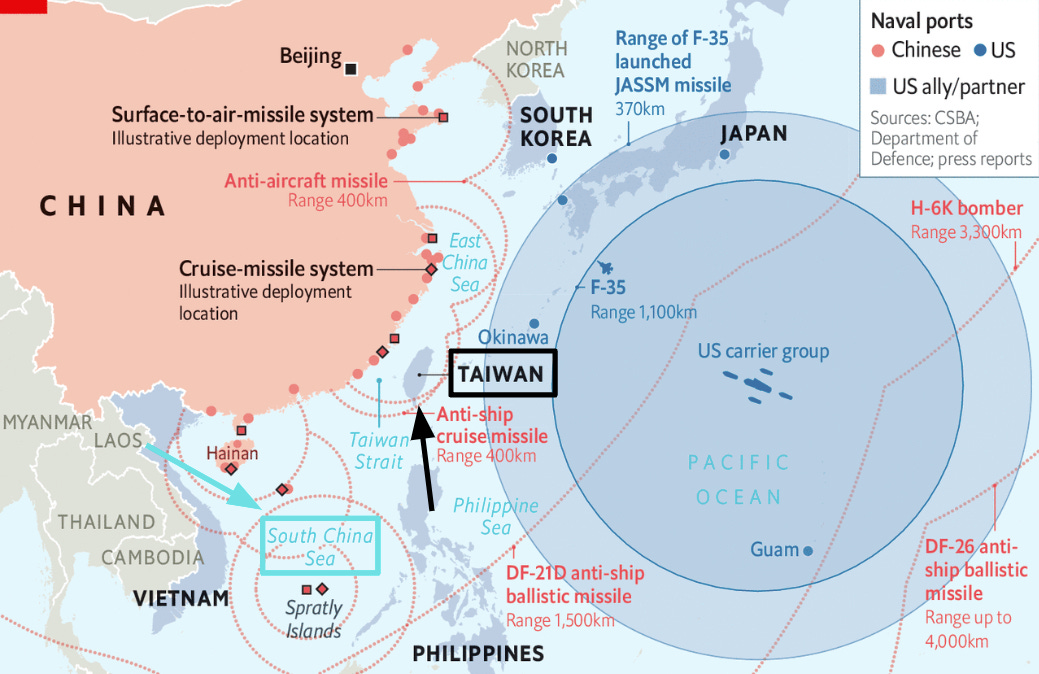As the Russian invasion of Ukraine progresses to its eight week, I hope it does not distract us from our main foreign policy challenge. As Nicholas Kristoff writes in Foreign Affairs
The rise of China, if it continues, may be the most important trend in the world for the next century.
Nine-Dash Line
China represents the greatest naval challenge to the US since Imperial Japan. China may be able to field six aircraft carriers by the 2030s. With that power I expect the Chinese Navy to eventually declare ownership of the entire South China Sea, represented by the nine-dash line.
Where did the nine-dash line originate? Quartz reports
The dashed line was first shown in 1947 on a map entitled “Map of South China Sea Islands” published by the government of the Republic of China. With 11 dashes at the time, it encompassed most of the South China Sea. The Chinese communist party adopted the map in 1949, but removed two dashes to give the Gulf of Tonkin to communist Vietnam as a courtesy
To enforce the nine-dash line and China’s other claims like Taiwan, China employs a strategy called Anti-Access/Area Denial (A2/AD). The Missile Defense Advocacy Alliance states that the purpose of China’s A2/AD is to
[use] advanced ballistic and cruise missiles in conjunction with air and maritime defense systems to deter U.S. military operations in the region.
The Anti-Ship Ballistic Missile is critical to the success of A2/AD. ASBMs can potentially sink an aircraft carrier, or at least halt fighter jet activity by cratering the carrier’s runway. Last Week China tested an air launched ASBM and potentially a sea launched ASBM. As China’s ASBM capabilities increase, US officials plan to counter this strategy.
America Readies Its Queens
Two months ago I labeled the stealthy, 5th generation F-35 as Queens on the Naval Chessboard. The US recently conduced two naval exercises featuring 28 F-35s in October 2021 and 26 F-35s in January, the largest gatherings of naval F-35s to date.
These exercises demonstrate the most lethal force America’s navy can muster. Rear Adm. Dan Martin, commander of one of the carrier groups made a not too thinly veiled threat to China by stating the purpose of these exercise is to
[ensure] the lawful use of the sea and free flow of commerce while deterring those who challenge the shared vision of a free and open Indo-Pacific now and into the long-term future
Unfortunately, I question the efficacy of our ability to deter China in the South China Sea and Taiwan.
Keeping America at Arms Length
A map from The Economist showcases our perilous situation. We will break down seven aspects of the graphic and show how a US carrier group may fare poorly against China’s defenses.
1. Let’s begin with the US. The F-35, who boasts a fighting range of 1,100 kilometers (km), will lead the charge into the China’s impressive array of S-300 and S-400 air defense systems.
2. The Economist models the effect of the Joint Air-to-Surface Standoff Missile (JASSM) being fired from the F-35. The JASSM’s 370km range means that the F-35 firing a JASSM can launch and strike a target 1,470km from the aircraft carrier.
3. Unfortunately for the US, Chinese defenses will make it difficult to project power against China in both the South China Sea and Taiwan. The graphic shows that China’s A2/AD system can threaten an aircraft carrier arriving to assist Taiwan if China invades or to deny China its claim to the entire South China Sea.
4. What is halting the F-35? China’s anti-aircraft system, another key component of their A2/AD strategy can strike aircraft 400km away.
5. What is keeping the aircraft carrier parked so far away? The DF-21, one of China’s important ASBMs, can hit a carrier from 1,500km away.
6. In January 2024 the US will receive the missile called JASSM Extended Range (JASSM-XR) featuring a range of 1,800km, which allows the JASSM-XR to travel 1,430km farther than the original JASSM. Despite the impressive range of this new missile, it still leaves the US carrier group within the 3,300km range of the Chinese H-6K bomber.
7. The US carrier group not only remains threatened by the H-6K bomber, the DF-26 ASBM can strike targets 700km farther than the H-6K.
In writing about the Russian/Ukrainian war I discussed the vital role played by air defense systems. Let’s hope the US never needs to test the efficacy of not only China’s air defense system, but the entire web of A2/AD systems described in these graphics.











